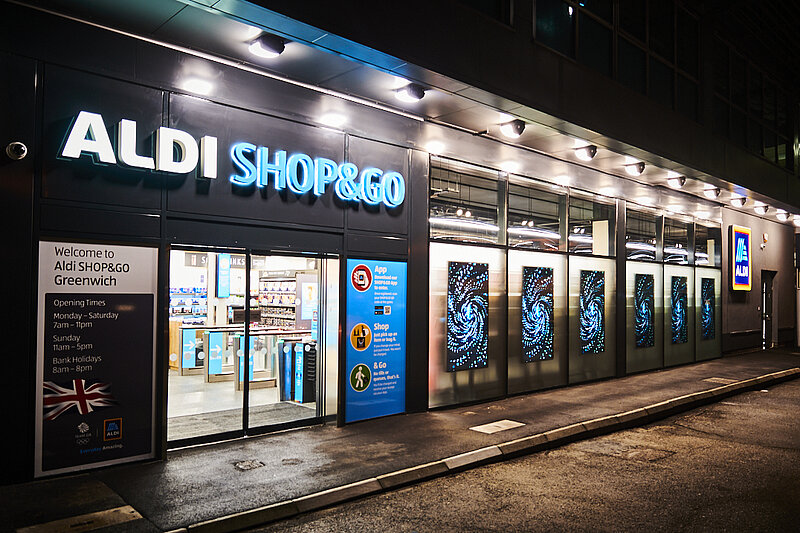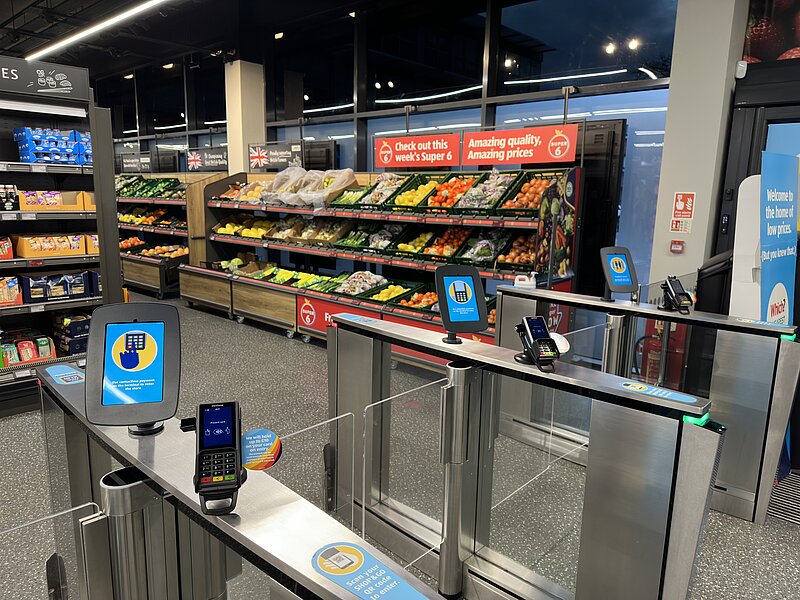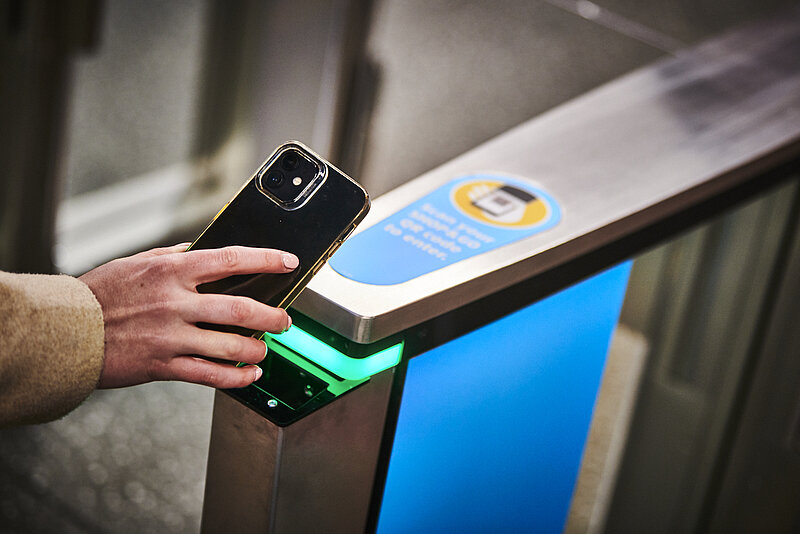
Shopping without a till thanks to cameras and AI
At ALDI SÜD, innovation and customer satisfaction go hand in hand. Both SHOP&GO and the new Tap In payment option are prime examples of this. Find out how our Innovation team used AI, cameras and its own app to create one of the largest cashierless stores in the world.
The idea: shopping without tills
“Is it possible to have a discount retailer without tills?” That’s what we asked ourselves when the idea of SHOP&GO was first proposed. After all, SHOP&GO is all about experimenting with a completely new way of shopping: no traditional checkout, no active payment process, no waiting, no cash, no actual tills. At the SHOP&GO pilot store in London, customers can simply pack up their purchases and leave.

“Our goal with SHOP&GO is to provide our customers with a seamless shopping experience and to make shopping even easier,” said Dustin, Project Manager in the Innovation team at ALDI DX. “It’s about saving time and making the customer journey as convenient as possible.”
How the SHOP&GO store works: cameras and AI change the game
In the SHOP&GO store, our customers must identify themselves at the entrance. When the store opened in 2021, this was initially only possible via a dedicated app, which was used to check in and store payment information. At the end of the shopping trip, customers could simply leave the store without having to wait. The receipt was then available in the app. Spoiler alert: now, you don’t even need the app – but more on this later.

Our Innovation team has set up a dedicated test lab or “test store” at our Mülheim office location to help identify challenges and drive the project forward. “It took a lot of pioneering work with innovative people. Nothing like this had ever been tried before at ALDI SÜD – nothing even close,” said Dustin, reflecting on the project’s beginnings. There were no processes in place and there was no direct connection between the AI and ALDI SÜD’s system landscape. The team completely redesigned these processes. SHOP&GO uses artificial intelligence to identify what products a person puts into their backpack or shopping bag using anonymised camera images. A customer’s purchase is tracked by an in-store device without the need for a till or scanner. The AI device recognises which products are being taken. However, it also recognises when customers simply look at a product and put it back on the shelf.
The AI device had to be trained before this process functioned properly. Dustin’s team did a lot of this training themselves. For this, they spent a lot of time in the lab and at the SHOP&GO store in London, where they experimented and looked for answers to questions like these: will the AI be able to recognise ALDI SÜD products in our environment? Can it differentiate between products with very similar packaging? The team used feedback to continually train the AI, checking which products it recognised correctly and which it did not. “This was the biggest and most important task. The AI had to be able to correctly identify and assign products in our store. This was especially challenging as, one of ALDI SÜD’s peculiarities as a discount retailer is that its products are often displayed in larger packages or on pallets and are not always clearly separated from each other.”
The team also developed a dedicated app. To do so, they followed an agile approach and always kept the following question in mind: does our approach suit the project? Until the go-live, the Scrum methodology was used. Later, when the project had moved beyond pure (further) development, the team scrutinised the use of Scrum together with the developers. They realised that the fixed sprints in Scrum were too restrictive after go-live, and opted for a more flexible framework with Kanban.
This has significantly increased efficiency in terms of hypercare, support and prompt bug fixing. It also meant that there was more time to work on store development and customer journey topics.
So, while they started with Scrum, they decided to use Kanban in the end. Choosing the right work approach allows us at ALDI DX, to achieve the best possible results. Throughout the project, there was always interaction with other departments, such as our Cloud, Data Protection and Infrastructure teams. This is because the virtual checkout, which is invisible to the customer but runs in the background and calculates the total purchase value, must be able to work with product data as well as fully understand and use ALDI SÜD’s checkout system. Our team is proud to have built an entire store concept and systems around artificial intelligence – and rightly so! There are many elements involved, e.g. servers, sensors, payment systems, product data systems, the app, back-end systems, AI, and they all need to be able to communicate with each other.
Evolution of the revolution: introducing Tap In
Once the store and the app were up and running, the team conducted on-site surveys in London to further improve the system and the shopping experience. Results showed that many customers found it difficult to download the app, register and enter their credit card details, which discouraged some customers from shopping in the cashierless store as a result. This is how the idea for the Tap In payment option came about. Thanks to this innovative solution, customers only have to present their credit card when entering the SHOP&GO store. Londoners are already familiar with this system, as it’s a similar process to catching tube. As of January 2024, it has been possible to shop at SHOP&GO without an app, using only a credit card instead.

How our Innovation department works
When asked about how his team works, Dustin replied: “All my team members pay close attention to what’s going on in the market right now. So, when we considered the possibility of cashierless stores, our first questions were: can this even be integrated into the ALDI SÜD world? How would this work in terms of technology, data and processes? What do customers expect?” Using pilot projects, prototypes or Minimum Viable Products (MVPs), the team strategically tests whether innovations make sense for ALDI SÜD or what, if any, hurdles there are for customers. The best example of this is SHOP&GO. It was innovative and completely new. Not just for us, but our customers as well. With Tap In, for example, we were able to take feedback directly on board and further develop our original idea. Now it’s possible to shop without a till, and even without an app if you prefer.
Reprogram retail. What’s next?
At ALDI DX, the only constant is change. This gives you the chance to work on innovative IT topics. Browse through our open positions now and find a job that suits you!

